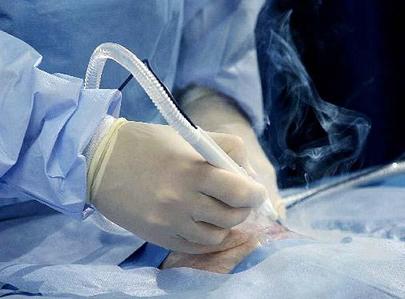
The surgeon touches an area of exposed flesh with a cauterizing tool for less than a minute, sending up a cloud of noxious smoke that quickly wafts across the room and catches at the eyes and throat.
It is only a demonstration - the flesh is actually raw turkey - but the result illustrates the hazard that doctors, nurses and even patients can be exposed to during operations that employ lasers and other tissue-burning tools.
Known as "plume," the smoke is laden with all manner of potentially toxic substances and disease-causing microbes that can make their way past surgical masks and into the lungs.
"According to one study, exposure to (vapours from) one gram of laser-cut tissue is like smoking three unfiltered cigarettes," said Suzanne Kiraly, president of the Canadian Standards Association (CSA), which on Wednesday released new guidelines for capturing and disposing surgical plume.
"Thus far, researchers have identified more than 600 organic compounds in plume generated by vaporized tissue," Kiraly told a news conference at Women's College Hospital in Toronto, where the demonstration took place.
"Many of these compounds have harmful health effects that have been documented, and these effects include irritation to the eyes, nose and throat, liver and kidney damage, carcinogenic cell changes, headaches, dizziness and drowsiness, to name a few."
In one case, a surgeon developed a rare throat tumour caused by human papillomavirus (HPV). Tests revealed the tumour contained HPV DNA types identical to those of patients he had treated with a laser. Doctors concluded the virus may have been transmitted through plume rising from the lasered tissue.
While many Canadian hospitals already use plume-evacuation systems, there are many that do not, said Susan Taylor, a nurse educator at St. Joseph's Health Care in London, Ont., who was part of the expert committee that designed the new standards.
It's not known how many Canadian hospitals do not use the equipment, she said, but their adoption has the "potential to improve the quality of life for thousands of health-care workers in Canada."
Patients have the lowest risk for inhaling the vapours, as they are usually on a breathing machine during surgery, said Taylor.
The new voluntary standards, contained in a 30-page booklet that can be bought for $110 from the not-for-profit CSA, are aimed at hospitals, dental offices, veterinary clinics and spas that use tissue-burning tools.
The guidelines are aimed at helping such organizations decide what kind of equipment to purchase, how to use it properly and how to maintain it.
Dr. John Semple, chief of surgery at Women's College, said the hospital has been using plume-capturing equipment in its operating rooms for the last decade. But before that, surgical teams could be exposed to hours of toxic vapours during lengthy operations.
"We used to work all day like this," said Semple, accompanied by the sound of sizzling as he wielded his cautery iron over the turkey.
But with the flick of a switch on a nearby portable plume-evacuating machine, the tissue-searing tool begins sucking in the smoke as it cuts into the flesh. Filters inside the machine that grab toxic material from the plume are later discarded as biohazardous waste.
Dr. Steven Dain, who has helped develop medical standards for the last 15 years, said that with the number of surgical procedures on the rise and an increased use of electrocautery and lasers to perform them, inhaling airborne contaminants is a growing problem.
"Surgical plume can contain a variety of contaminants," said Dain, associative professor of anesthesia and perioperative medicine at the University of Western Ontario in London.
Those curling vapours can include cellular debris, toxic metals and chemicals such as benzene and hydrogen cyanide, he explained.
"One of the greatest concerns, however, is that these plumes can contain aerosolized blood and blood-borne pathogens," among them E. coli, Staphylococcus aureus and HIV. Such microbes can remain viable for up to 72 hours.
"The use of the standard will help promote safer conditions for patients and health-care staff in operating rooms and for other ... persons exposed to plume in other settings."
Source - The Canadian Press



Comment: While reporting on a legitimate problem, mainstream medicine can't resist getting a dig in at smoking. What cigarette or pipe tobacco will ever contain "aerosolized blood and blood-borne pathogens"? The two are hardly equatable.